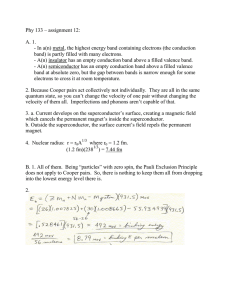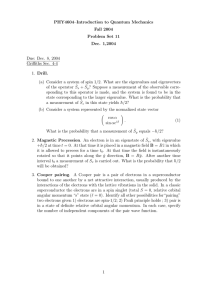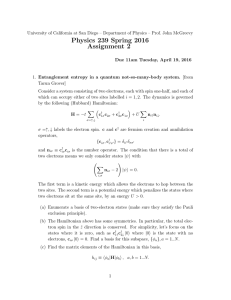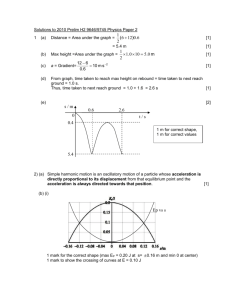Document 13445397
advertisement
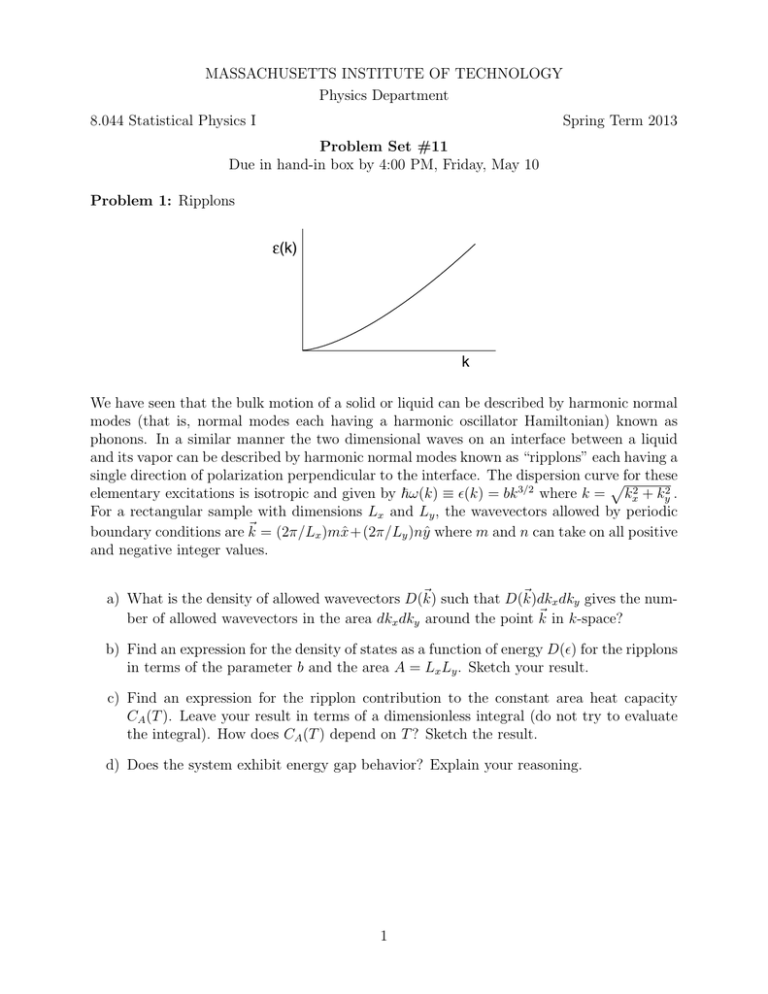
MASSACHUSETTS INSTITUTE OF TECHNOLOGY Physics Department 8.044 Statistical Physics I Spring Term 2013 Problem Set #11 Due in hand-in box by 4:00 PM, Friday, May 10 Problem 1: Ripplons (k) k We have seen that the bulk motion of a solid or liquid can be described by harmonic normal modes (that is, normal modes each having a harmonic oscillator Hamiltonian) known as phonons. In a similar manner the two dimensional waves on an interface between a liquid and its vapor can be described by harmonic normal modes known as “ripplons” each having a single direction of polarization perpendicular to the interface. The dispersion curve these efor 3/2 2 elementary excitations is isotropic and given by fω(k) ≡ f(k) = bk where k = kx + ky2 . For a rectangular sample with dimensions Lx and Ly , the wavevectors allowed by periodic boundary conditions are kk = (2π/Lx )mx̂+(2π/Ly )nŷ where m and n can take on all positive and negative integer values. a) What is the density of allowed wavevectors D(kk) such that D(kk)dkx dky gives the num­ ber of allowed wavevectors in the area dkx dky around the point kk in k-space? b) Find an expression for the density of states as a function of energy D(f) for the ripplons in terms of the parameter b and the area A = Lx Ly . Sketch your result. c) Find an expression for the ripplon contribution to the constant area heat capacity CA (T ). Leave your result in terms of a dimensionless integral (do not try to evaluate the integral). How does CA (T ) depend on T ? Sketch the result. d) Does the system exhibit energy gap behavior? Explain your reasoning. 1 Problem 2: Two-Dimensional Metal constant energy contour ε ky kx ky kx We have studied electrons moving in a box in which the potential energy was zero. Alter­ natively one could consider electrons moving in a box containing a periodic potential – a simple model for the conduction electrons in a metal with a crystalline lattice. Under these conditions the single particle states can still be indexed by a wavevector kk; however, the energy of each state f(kk) need not be quadratic in kk nor even isotropic in space. The figure at the left above shows an approximation to the dispersion relation, f(kk), in a particular two-dimensional metal∗ . The energy has the form of an inverted square pyramid. It has four-fold rotational symmetry. Along the kx direction the energy is given by f(kx ) = γkx . The figure on the right shows a contour of constant energy on the kx , ky plane. a) If one imposes periodic boundary conditions on the electron wavefunctions in a square sample of side L, what are the allowed values of the wavevector kk? b) Find D(kk), the density of allowed wavevectors as a function of kk. c) Find D(f), the density of single particle states for the electrons as a function of their energy f. Make a carefully labeled sketch of your result. d) The metal contains N conduction electrons. Find the Fermi energy fF , the energy of the last single particle state occupied at T = 0. e) Find the total energy of the electrons at T = 0 in terms of N and fF . f) Without doing any calculations, indicate how the electronic heat capacity depends on the temperature for temperatures T << fF /kB . g) What is the surface tension S (the negative of the spreading pressure) of the electron gas at T = 0? ∗ Two dimensional planes of conduction electrons are not a fiction. They play an important role in semiconductor electronics and in high temperature superconductivity. 2 Problem 3: Donor Impurity States in a Semiconductor In lecture we studied the behavior of electrons in an intrinsic (pure) semiconductor. We found the temperature dependence of the number of electrons in the conduction band and found an expression for the temperature dependence of the chemical potential. Intrinsic semiconductors are nice systems to study, but not very useful for semiconductor electronics because of the strong dependence of the number of carriers on temperature. One would pre­ fer a semiconductor where the number of carriers depends only weakly on temperature, but can be influenced by applied voltages through the position of the conduction band relative to the chemical potential. This can be done by doping the semiconductor with impurities that can easily donate an outer electron to the fluid of mobile electrons in the conduction band. The density of states for such a system is shown below. D(ε) doped semiconductor εF ε On the left one has the density of states associated with the top of the valence band. All these states are occupied at T = 0. The delta function represents ND impurity states (one electron per impurity) located somewhere within the energy gap of the intrinsic material. They too are completely occupied at T = 0. On the right one has the density of states associated with the bottom of the conduction band. These states are completely vacant at T = 0. Considering the step-wise nature of the mean occupation number < n > at T = 0, the Fermi energy fF (the chemical potential at T = 0) must lie above the energy of the impurities and below the bottom of the conduction band. As the temperature is raised from zero, electrons will first be thermally promoted from impurity states into the valance band and then at a much higher temperature, after the impurities have lost almost all of their electrons, electrons will be promoted from the valance band to the conduction band. Analysis of this situation is complicated by the fact that during this process the chemical potential will drop through and below the impurity energy. One may be able to use approximations for < n > in the two bands, but one has to use the full form for < n > applied to the impurity states. We will study some aspects of a simplified model of this situation. 3 We will neglect the valance band entirely. Set f = 0 at the position of the impurity states and let Δ be the position of the bottom of the conduction band. D(ε) 0 ε ∆ µ εF The exact position of the Fermi energy fF is yet to be determined, and the location of the chemical potential µ will change with temperature. Analytically we have V D(f) = ND δ(f) + 2 2π � 2me f2 �3/2 (f − Δ)1/2 where the second term is only present where f > Δ. In the following we will make the approximation, realized in practice, that Δ » kB T . Before starting, you should review the intrinsic semiconductor example presented at the end of Lecture 19. a) A useful parameter For a fixed value of the chemical potential, show that the number of electrons in the conduction band, NC can be written in the form NC = α(T )e−Δ/kB T eµ/kB T where α(T ) is a useful dimensionless parameter, proportional to T 3/2 , with magnitude comparable to the number of donors. Using this parameter will simplify subsequent calculations. b) A reference temperature Find an equation, which when solved, gives the temperature at which exactly one half of the donor sites are empty. Do not attempt to solve the equation. c) Behavior of µ(T ) at very low temperatures Assume that µ starts out for very low temperatures somewhere near the center of the region between f = 0 and f = Δ so that we can use the approximate expressions for < n > both at the donor energy f = 0, and inside the conduction band. In this case, find an analytic expression for µ(T ). Use the fact that limx→0 (x ln x) = 0 to show that the Fermi energy for this system is given by fF = Δ/2. 4 d) Full equation for NC First find the number of electrons on the donors using the exact expression for < n >. This will involve e−µ/kB T. You can eliminate e−µ/kB T from the result by inverting the expression you found in a) to isolate e−µ/kB T , then substituting this into your first result. Next use the fact that the number of electrons on the donors plus NC must equal the total number of electrons ND . Show that (after a fair amount of algebra) this leads to the quadratic equation for NC /ND � NC ND � 2 � + NC ND � α −Δ/kB T α −Δ/kB T e − e =0 ND ND Check to see that this is consistent with the result you found in b). Without solving the quadratic equation show that it gives the expected results limT →0 NC /ND → 0 and limkB T » Δ NC /ND → 1. Problem 4: Spin Polarization Consider a 3-dimensional non-interacting quantum gas of s = 1/2 Fermions. The two possible spin states are ms = 1/2 and ms = −1/2. In a uniform magnetic field Hẑ the single particle energies depend on the direction of the spin relative to the field: f = f2 k 2 /2m − 2µ0 Hms where µ0 is a constant with the units of magnetic moment. a) Find the density of states as a function of energy separately for the particles with spin parallel and antiparallel to the external field, D1/2 (f) and D−1/2 (f). Make a careful sketch of the total density of states as a function of energy D(f) = D1/2 (f) + D−1/2 (f). b) For N particles in a volume V at absolute zero (T = 0), find an expression for the minimum magnetic field H0 that will give rise to total polarization of the spins, that is no particles left with the high energy spin orientation. c) Evaluate H0 in Tesla (one Tesla = 104 Gauss) for the electrons in copper where the electronic magnetic moment µ0 = −9.27 × 10−21 ergs-gauss−1 , the particle mass m = 9.11 × 10−28 grams and the number density of conduction electrons is n ≡ N/V = 8.45 × 1022 cm−3 . d) Evaluate H0 in Tesla for liquid 3 He where the magnetic moment is that of the nucleus with µ0 = 1.075 × 10−23 ergs-gauss−1 , m = 5.01 × 10−24 grams and the number density of atoms in the liquid is n = 1.64 × 1022 cm−3 . One can now buy commercial superconducting solenoids for laboratory research that go up to about 15 Tesla, and at the National High Magnetic Field Laboratory one can obtain continuous fields up to 45 Tesla and pulsed fields as high as 100 Tesla. As you can see, we are a long way from being able to completely polarize either of these systems by brute force. 5 Problem 5: T = 0 solubility of 3 He in 4 He Helium has two stable isotopes. The common isotope, 4 He, has nuclear spin 0 and is a composite Boson. The rare lighter isotope, 3 He, has nuclear spin 1/2 and is a composite Fermion. Helium atoms interact by a pairwise attractive Van der Waals interaction which is the same for both isotopes. At very low temperatures a liquid mixture of the two isotopes separates into a 3 He rich phase and a 4 He rich phase as shown above. At T = 0 the 3 He rich phase becomes pure 3 He; however, the 4 He rich phase can contain 3 He up to a critical concentration N3 /(N3 + N4 ) = n3 /(n3 +n4 ) = xC . Here n3 and n4 represent the number densities, N/V , of the two isotopes. The finite solubility of 3 He in 4 He at T = 0 can be understood in terms of a simple model. Because the quantum mechanical zero point motion of the lighter isotope is greater than that of the heavy isotope, the atoms in pure liquid 3 He are farther apart than the atoms in liquid 4 He. As a result, the energy of a single 3 He atom dissolved in bulk 4 He is lower than it would be if added to bulk 3 He due to the closer proximity of its neighbors. This can be viewed as a potential energy difference of W between the two phases as shown above. As more 3 He atoms are dissolved in the 4 He rich phase they behave as free particles with an effective mass m∗ arising from their motion through the background fluid. A dissolved 3 He atom with momentum fk has an associated kinetic energy f(k) = f2 k 2 /2m∗ . 3 He will dissolve in the 4 He until the total energy, potential plus kinetic, necessary to add another atom exceeds that of having it join the bulk 3 He liquid. a) Find an expression for the maximum number density of 3 He atoms that can be dissolved in 4 He at T = 0. b) Check to see if your answer in a) is reasonable by estimating xC using the following values: f ≈ 1 × 10−27 erg-sec, kB ≈ 1 × 10−16 erg-o K −1 , m∗ ≈ 10 × 10−24 grams, W ≈ 0.5 o K, and n4 ≈ 2 × 1022 cm−3 . 6 Problem 6: Melting Curve of 3 He I II III 3 He is a composite Fermion (nuclear spin = 1/2) that remains a liquid under its own vapor pressure down to T = 0. When compressed at low temperatures it solidifies at pressures of the order of 30 atmospheres. A phase diagram showing part of the melting curve is shown above. The phase diagram can be divided into three regions – I, II, and III – according to the temperature. In region III the temperature is too high to allow us to make simple models. In region II the liquid can be treated as a degenerate spin 1/2 Fermi gas with temperature so low that it can be considered to be at T = 0. The solid can be considered to be a collection of non-interacting spin 1/2 paramagnets fixed on specific lattice sites (thus the 3 He atoms in the solid phase are distinguishable). There is no magnetic field applied to the system. a) What is the entropy of N atoms of liquid in region II? b) What is the entropy of N atoms of solid in region II? In region I the liquid still behaves as a degenerate spin 1/2 Fermi gas. The nuclear spins in the solid become ordered in an antiferromagnetic state. In this state each nuclear spin behaves as if it were in an effective magnetic field Hef f (this effective field is caused by the alignment of all the other moments in the sample). We can assume that µHef f >> kT in region I. c) What is the entropy of the solid in region I (basically at T = 0)? (continued on next page) 7 The slope of the melting curve is given by the expression dPM ΔSs→l = dT ΔVs→l where ΔSs→l is the difference between the entropy of the liquid and that of the solid and ΔVs→l is the volume difference between the liquid and the solid. In 3 He, as in most well behaved systems, ΔVs→l is positive and we can assume that it is a temperature independent quantity N Δvo . d) What is the slope of the melting curve in region II? e) What is the slope of the melting curve in region I? f) Assume that the system is on the melting curve in region II, that is, the system has both liquid and solid coexisting in equilibrium. If heat is added to the system, will some of the solid melt or will some of the liquid solidify? Explain why. 8 MIT OpenCourseWare http://ocw.mit.edu 8.044 Statistical Physics I Spring 2013 For information about citing these materials or our Terms of Use, visit: http://ocw.mit.edu/terms.
